Following a very positive 2021/22 campaign in which he scored 21 goals (trailing only Monaco’s Wissam Ben-Yedder and PSG’s Kylian Mbappé) and provided four assists in 30 Ligue 1 appearances for Lyon, Moussa Dembélé (183cm/6’0, 74kg/163lbs) has fallen back into the periphery for Les Gones in 2022/23. The centre-forward has played just 35% of his team’s league minutes this term.
For quite a while, it seemed as though Dembélé was eyeing up life away from Lyon. Last season, his career at the Groupama Stadium sprang back into life but after a summer when he was heavily linked with a departure, with the likes of Manchester United, Villarreal and Juventus all batted about in the rumour mill as potential destinations for the attacker either last summer or for summer 2023 when he’s set to become a free agent — just to name a few — it now seems as though his time in Lyon is coming to an end, be that this month or, as just mentioned, in the summer when he becomes a free agent.
At the moment, EPL sides Everton and Aston Villa appear to be the teams most heavily linked with the Frenchman but there’ll undoubtedly be no shortage of suitors for the prolific frontman who has generated the highest xG per 90 (0.71) of any centre-forward with at least 800 minutes in Ligue 1 over the last calendar year (in which he’s registered a total of 2,047 minutes). On top of that, Dembélé is the third-highest goalscorer in Ligue 1 for the last calendar year, with 18 to his name, living up to L’Équipe journalist Bertrand Latour’s ‘scoring machine’ moniker.
With all of that said, it’s clear to us that with less than six months remaining on his current contract, the 26-year-old is a potentially excellent option for a club either competing in Europe or hoping to compete in Europe from one of the strongest divisions that the continent has to offer.
This tactical analysis and scout report will look at how the 26-year-old attacker can best fit into his potential new team’s tactics by analysing some key elements of his role within Lyon’s tactics over the last 12 months, with a particular focus on the Lyon man’s goalscoring. Our analysis will look at his typical shot positioning and shot selection, the kinds of runs we can expect Dembélé to make to consistently place himself so well in high-value goalscoring spots and his physicality, among other areas, to dissect the forward’s goalscoring game and show why he deserves to be so highly-coveted.
Mousa Dembélé Positioning and movement
We’ll kick off our scout report by analysing the 26-year-old’s positioning and movement — always two super important areas to analyse in a striker’s game. As mentioned, Dembélé has generated the highest xG per 90 of any centre-forward in Ligue 1 over the last calendar year. He’s also taken the fourth-most shots per 90 (3.25) among Ligue 1 centre-forwards in that time while maintaining a decent 51.35% shot accuracy rate and an impressive 24.32% conversion rate.
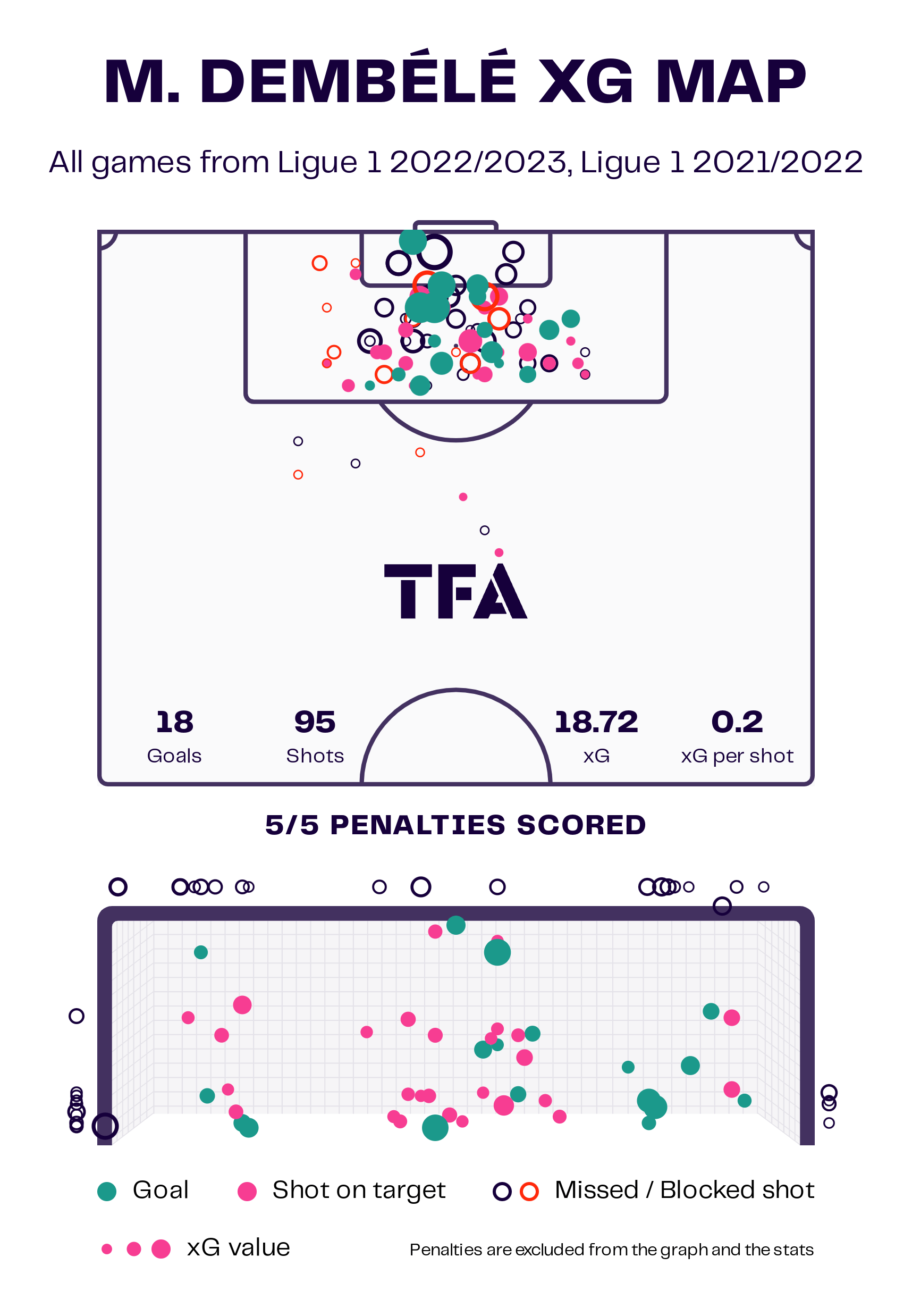
So, Dembélé’s generating a high volume of shots while typically taking those shots from good locations, as figure 1 indicates. The Lyon man has generated 0.2 xG per shot over the last two league seasons — the timeframe used for the xG map above. This is a good average xG per shot, highlighting a solid ability to frequently get shots off from high-value positions on behalf of the Frenchman.
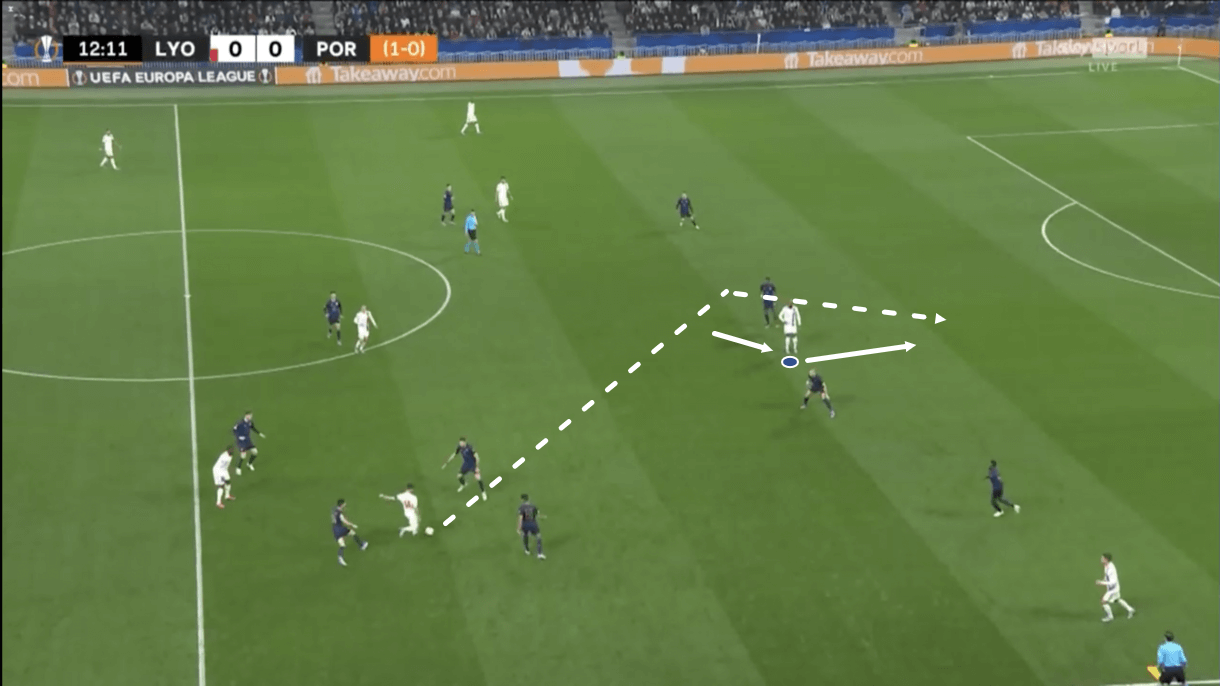
In the chance creation phase, we often see Dembélé sitting between the opposition’s centre-backs, right on that last line rearing to go and exploit the space behind the backline — obviously, against a higher defensive line, he’ll take up this position earlier as he’s more likely to get an opportunity to chase down a through pass from slightly deeper, as we see in figure 2.
As a deep-lying creator, it’s important to keep an eye out for his runs; you must be prepared as he’ll turn and burst away in an instant. If the passer can spot that movement in time, then your team is away behind the opposition for a 1v1 opportunity and in general, Dembélé is quite a composed finisher in 1v1s with a capacity to stroke the ball beyond the ‘keeper.
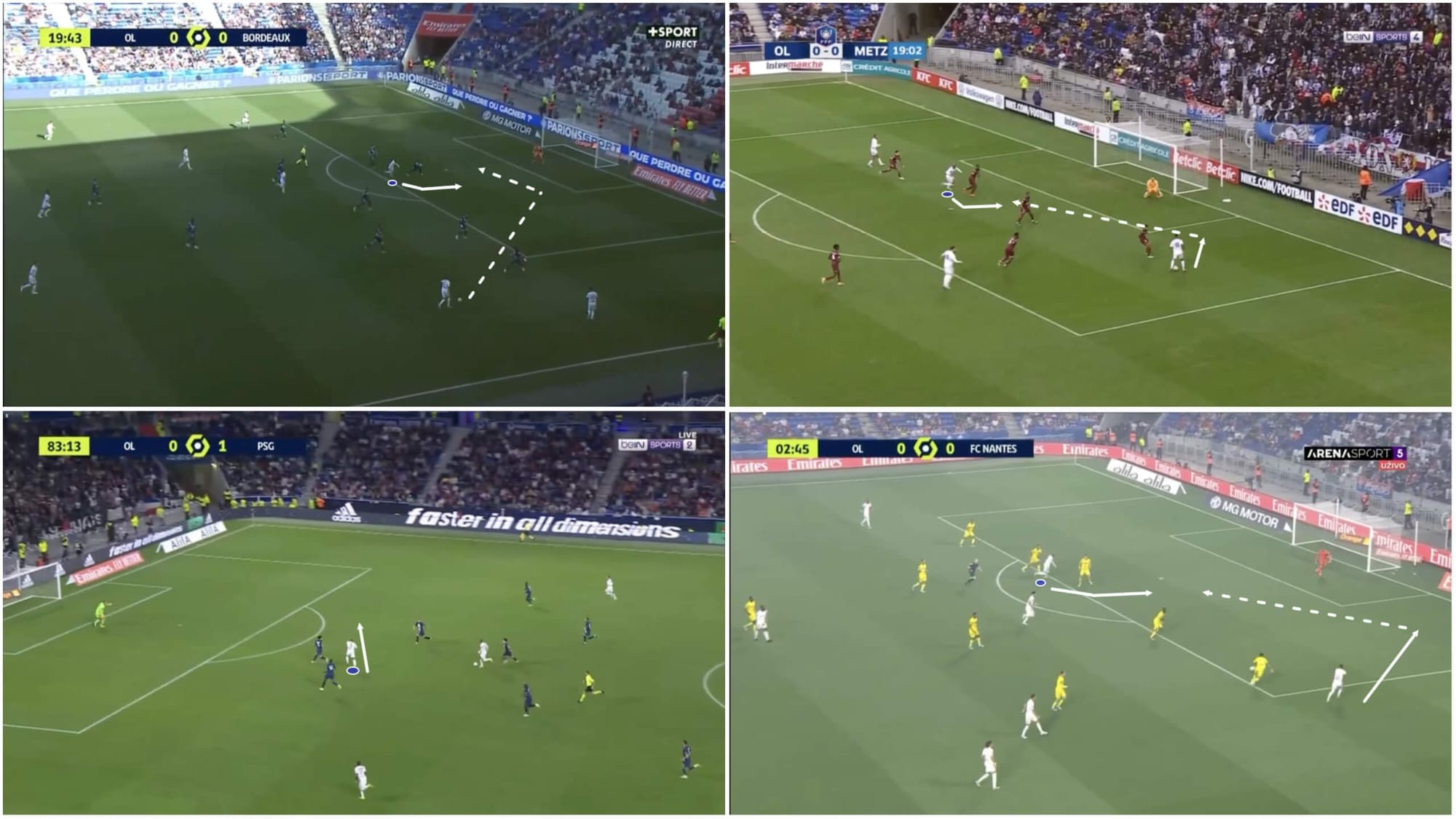
Dembélé often makes runs across the face of the nearest centre-back; we can see several examples of this in figure 3. In each of these examples, the striker starts behind the defender but makes his way across them, in some cases to create an easy passage for a low-drilled cross (the two examples on the right of figure 3), in the top-left example, to set himself up for an aerial ball which he heads home, and in the bottom-left example, to drift across the backline, moving from one centre-back’s zone to another, making himself difficult to mark and giving the ball carrier a very good through passing option.
All of these runs across the face of the centre-back can set up a typical Dembélé goalscoring opportunity — a calmly stroked first-time finish from a high-value position, a low drilled strike across the face of the ‘keeper from the right and a header with room for him to run onto the ball and gather some momentum for his leap over the defender.
Dembélé has scored five league headers over the last 12 months — more than any other Ligue 1 striker. His heading ability is an important element of his goalscoring game that can give his team an edge from crosses or set-pieces. Physically, he’s got an impressive leap that can allow him to hang in the air and tower over the defenders as he waits for the cross to reach him. He tends to jump over the opposition centre-backs powerfully but his run across the face of the defender helps him get an edge to meet the ball first as well.
We’d say it’s more common to see Dembélé looking to place the ball than it is to see him go for power. This is especially common for his first-time finishes, but he’s also good at receiving while turning, quickly setting himself and then stroking the ball towards the corners of the net.
However, when running across the defenders as we see in the bottom-left example above, intending to reach the far-right side of the box from where he can shoot across the goal, he typically goes for power and is generally good at keeping the ball down when doing so. However, such shots will sacrifice some accuracy and pull wide more often.
In the chance creation phase, it’s very rare to see Dembélé dropping to receive to feet. He’ll typically stay central, forego dropping off into space to receive to feet and prioritise providing an option on the defenders’ shoulders or looking for space in high-value positions for a cross to target.
However, in the progression phase, especially versus a deeper backline, when a creative pass is less likely to come, Dembélé will be found dropping into the half-spaces to link up with deeper teammates via short passes.
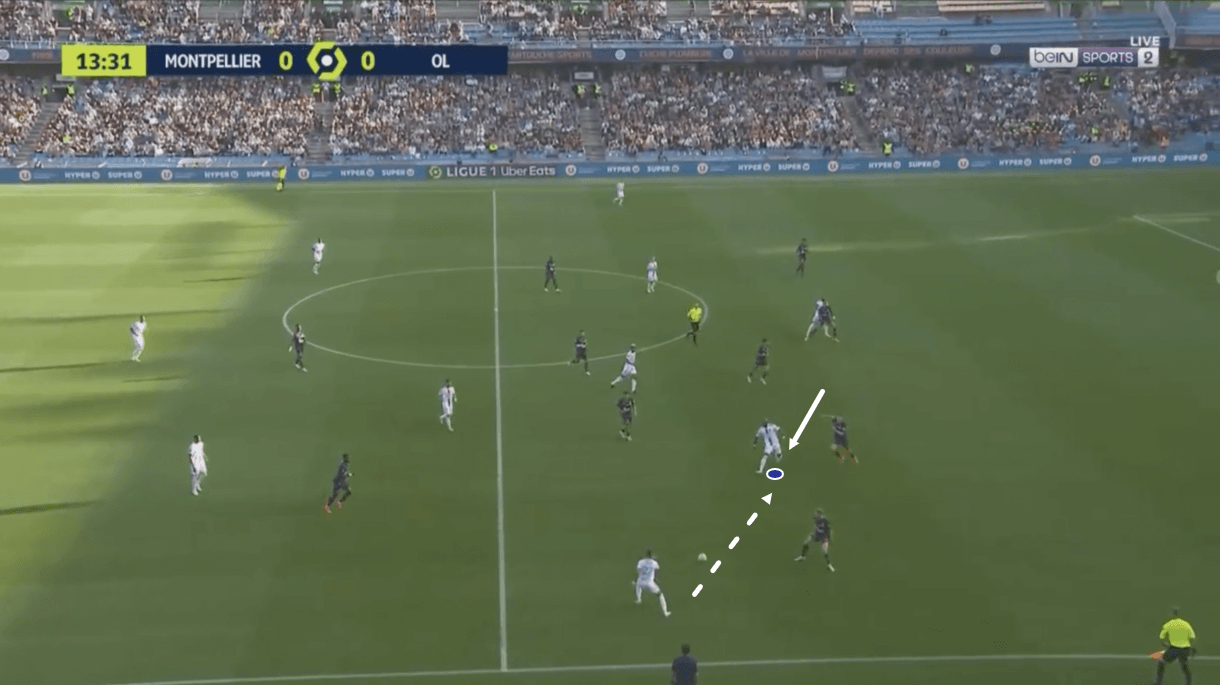
We see an example of this in figure 4. Dembélé is very much someone who likes to be involved in the game and, again, especially against deeper defences, this can be difficult at times when playing his typical game. So, we may see him drop off to get involved a bit more. But as the play progresses forward into more advanced stages of the attack, his focus shifts back to occupying those high-value central positions.
In terms of his passing and link-up play, Dembélé’s game isn’t always incredibly crisp and at times, his passes can make life difficult for the receiver to keep the ball under control, especially when he’s playing under pressure. In general, though, we wouldn’t describe this as a major area of concern, especially as this isn’t a key part of his natural game and not something we’d like or expect to see a tonne of from Dembélé.
Mousa Dembélé Physicality
We touched on Dembélé’s physicality in the previous section when discussing his aerial goalscoring threat. However, there’s more to discuss regarding his all-around physical game and other ways in which his physicality is useful apart from his jumping height and ability to score from headers (which is obviously very important!)
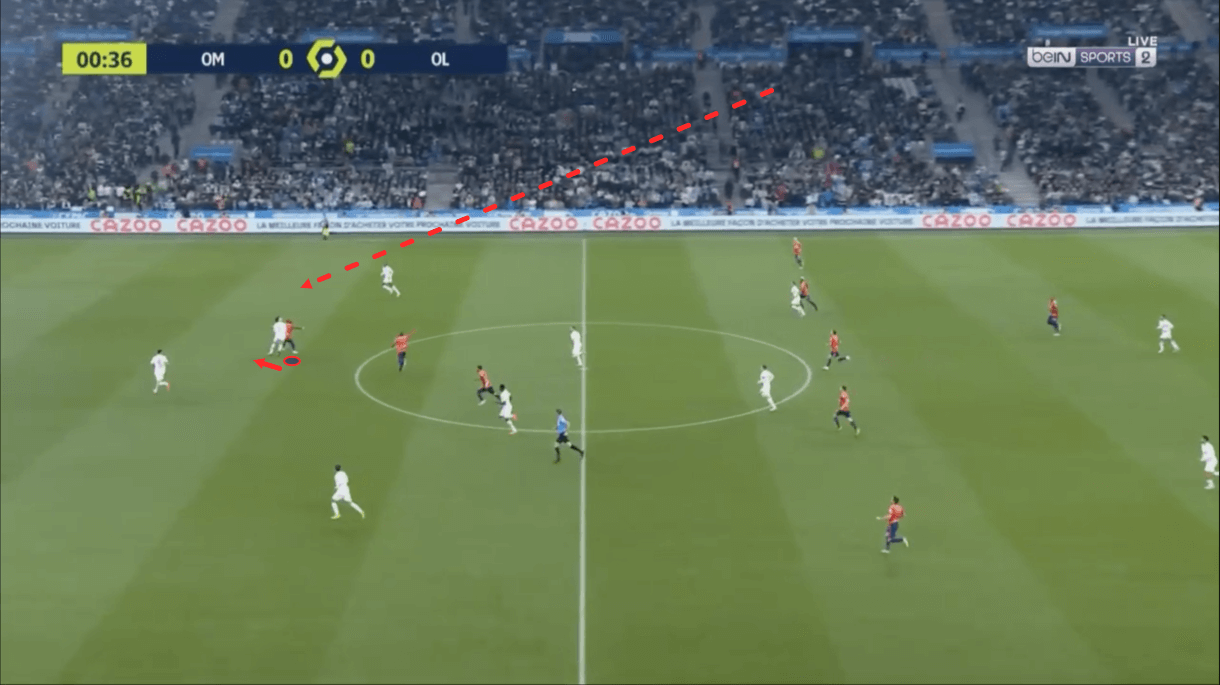
Firstly, sticking with what Dembélé offers the team aerially, he’s a great outlet for the team to aim at with long balls. For example, in figure 5, we see how Lyon’s goalkeeper targeted the 26-year-old from the goal-kick. As the ball flew towards Dembélé, the French attacker backed up into the centre-back, successfully forcing the defender to back up, giving Dembélé the position he wanted to meet the dropping long ball.
In general, Dembélé is very good at backing up into defenders and gaining some territory or protecting the ball, if he’s backing up into the defender while receiving a pass to feet or just after receiving a pass to feet.
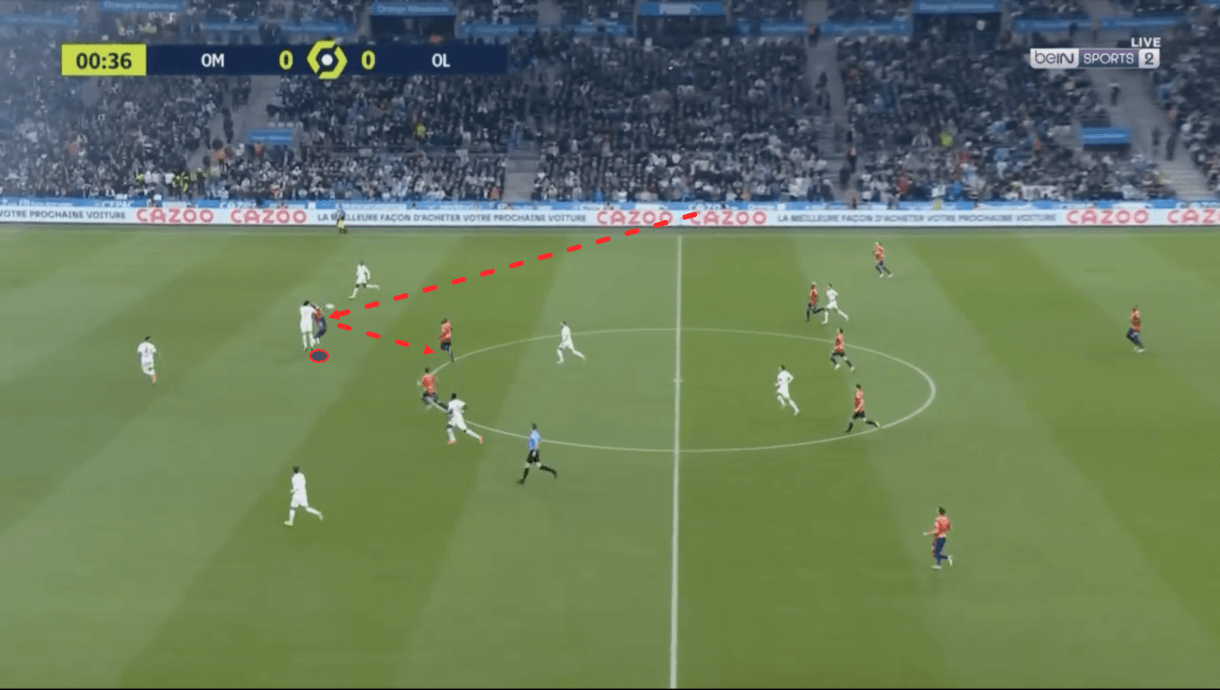
Here, as the ball drops, we see Dembélé knocking it down into the path of his teammate, setting up a good opportunity for Lyon to take the ball forward and put the opposition’s backline under serious pressure. However, the teammate failed to control the ball and the attack fizzled out. Regardless of the result on this occasion — they’ll never work out perfectly all the time — it’s clear how Dembélé’s physicality and aerial duel ability provide an excellent outlet for the team to progress the ball upfield and quickly put the opposition’s backline under pressure; this is an excellent outlet for Les Gones.
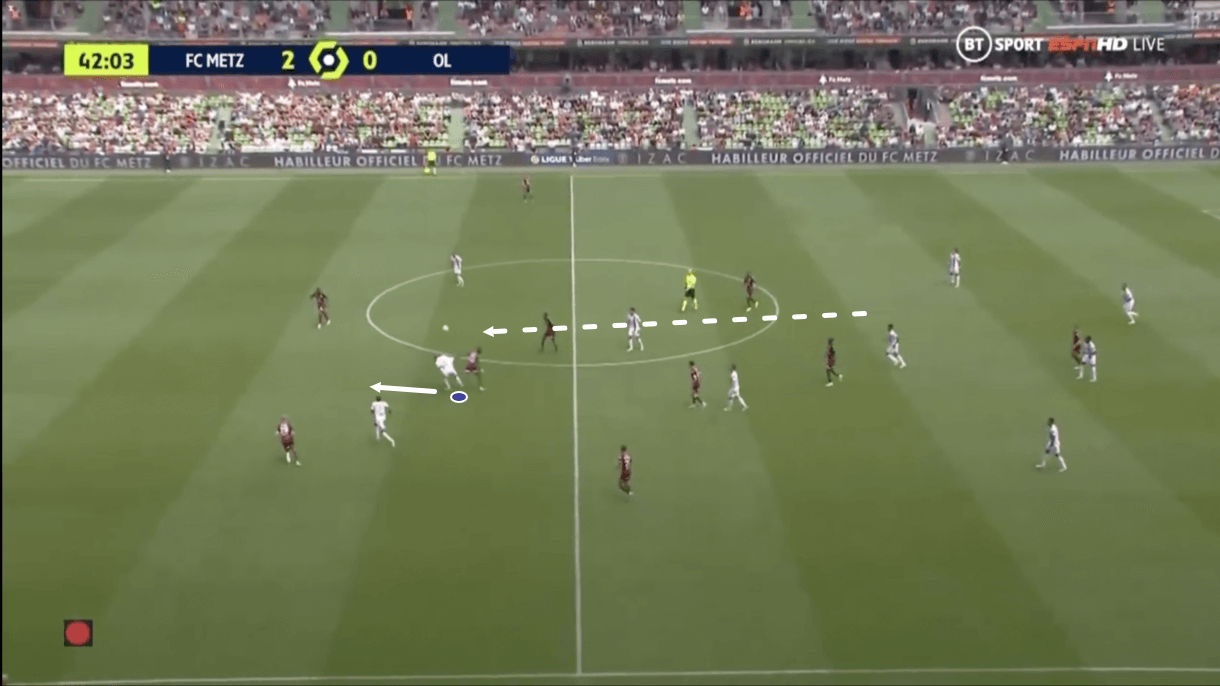
When looking to exploit space behind the opposition’s backline, one notable tendency of Dembélé’s is this tendency to give the opposition defender a slight nudge — not all the time but occasionally when possible and when helpful — to knock them off-balance just as the ball is being played through to him. This can give the 26-year-old an extra yard or two at least as he sets off on his run in behind.
We see an example of this intelligent little nudge in figure 7. This demonstrates a good tactical awareness in Dembélé’s game and intelligence with regard to how he can use his body to earn himself some extra time and space.
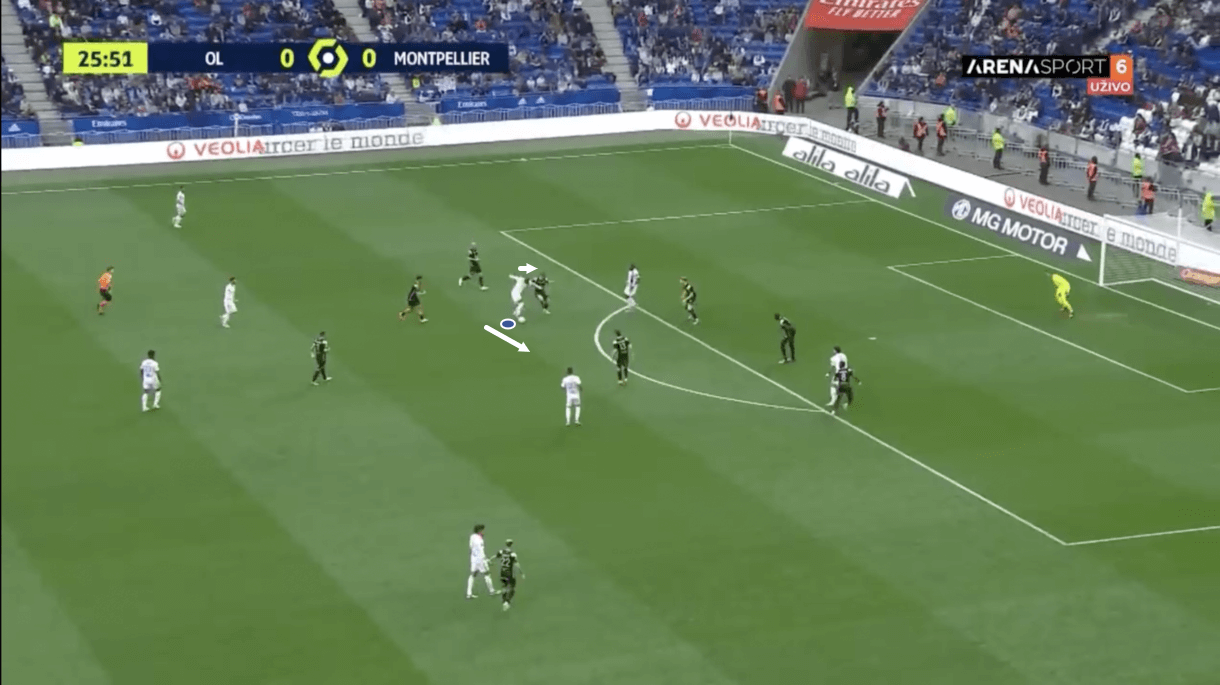
Lastly, when carrying the ball, a player can naturally attract pressure from defenders. Dembélé is good at coping under this pressure as he can use his strength to hold off a defender while still progressing towards goal and remaining in control of the ball. Again, this is an excellent example of the attacker being well aware of how to use his body — which not every attacker is always 100% comfortable with/knowledgable about.
Mousa Dembélé Dribbling
With 1.71 dribbles per 90 in the last calendar year, Dembélé is far from being the most high-frequency dribbler in Ligue 1 as far as centre-forwards are concerned. This won’t come as a surprise, as his game isn’t about dropping off into space, turning and running at the defence, rather it’s about what he offers off the ball in chance creation and how he can finish chances. But the well-rounded forward can deliver when he does take on dribbles — that doesn’t mean he should look to incorporate more into his game but it does mean it’s not a weakness that needs to be hidden or that opponents can necessarily target.
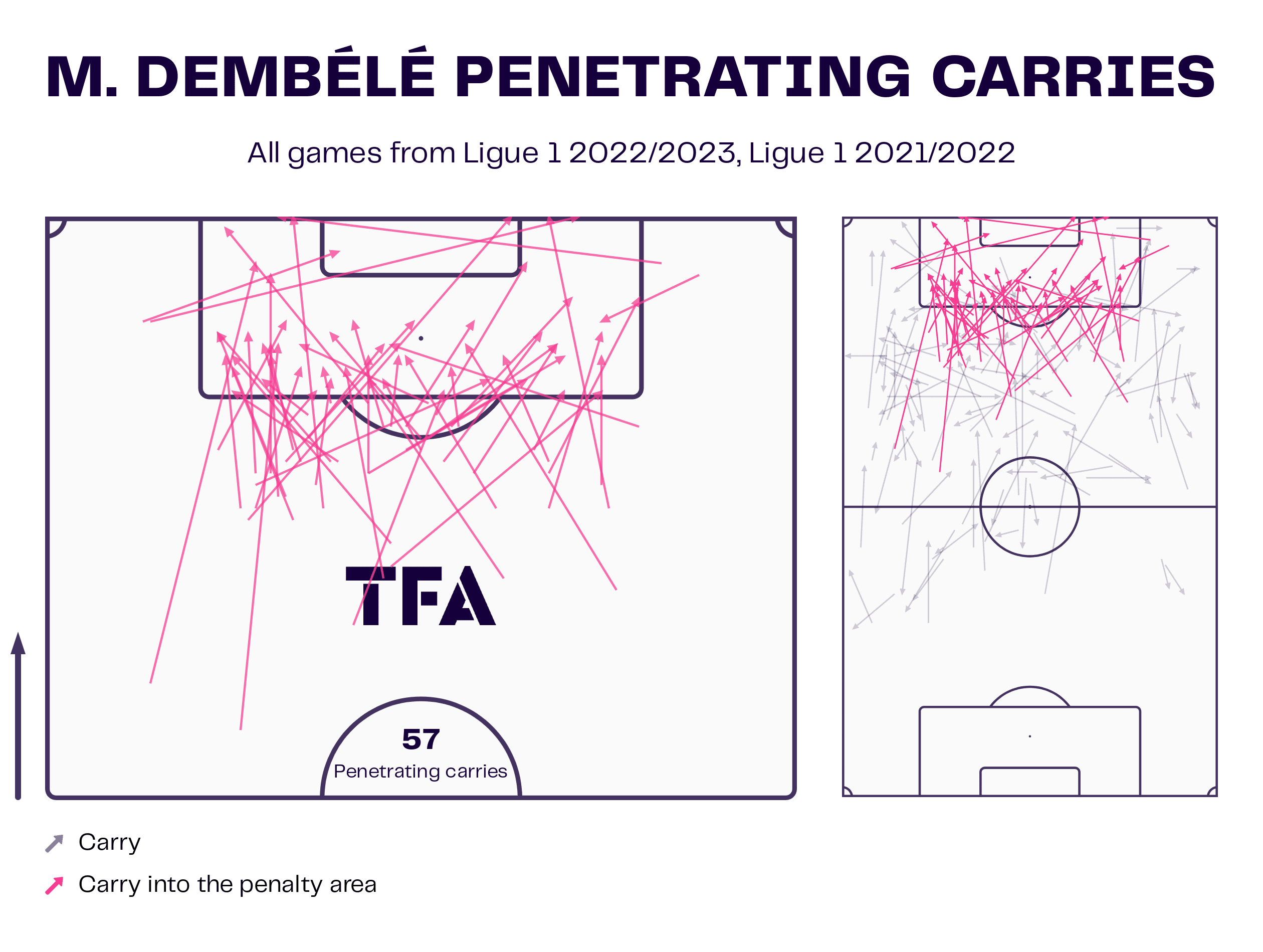
In earlier possession phases, we may find Dembélé dropping into the half-spaces — it’s not the most crucial element of his game, but it’s a part of his game that we can see. He pulls away into the left half-space a little more than the right, as he prefers progressing into shooting positions on this side where he can stroke the ball across goal rather than the other where he would probably have to drill the ball across goal and risk losing accuracy, as previously discussed.
Figure 9 displays Dembélé’s progressive runs from this season and last. We can see his slight preference for the left and his tendency to move diagonally when carrying the ball similar to his runs off-the-ball, in this image.
When coming in from the right or left, Dembélé’s good at shifting the ball between his feet to wrong-foot the defender and create a shooting angle around them. Additionally, he’s got a nice tendency to use the ball as bait a little bit, draw the defender in thinking they can nab it away from him just before he takes the ball away at the last second and continues his dribble; this is an especially useful skill inside the box, where space is often at a premium but moves like this one described can help open up more space.
When played in behind a high backline, Dembélé may need to carry the ball a little bit over some distance and his impressive ball control helps him to maintain his speed levels while carrying the ball over a distance — another valuable skill that can give him space when in the danger zone.
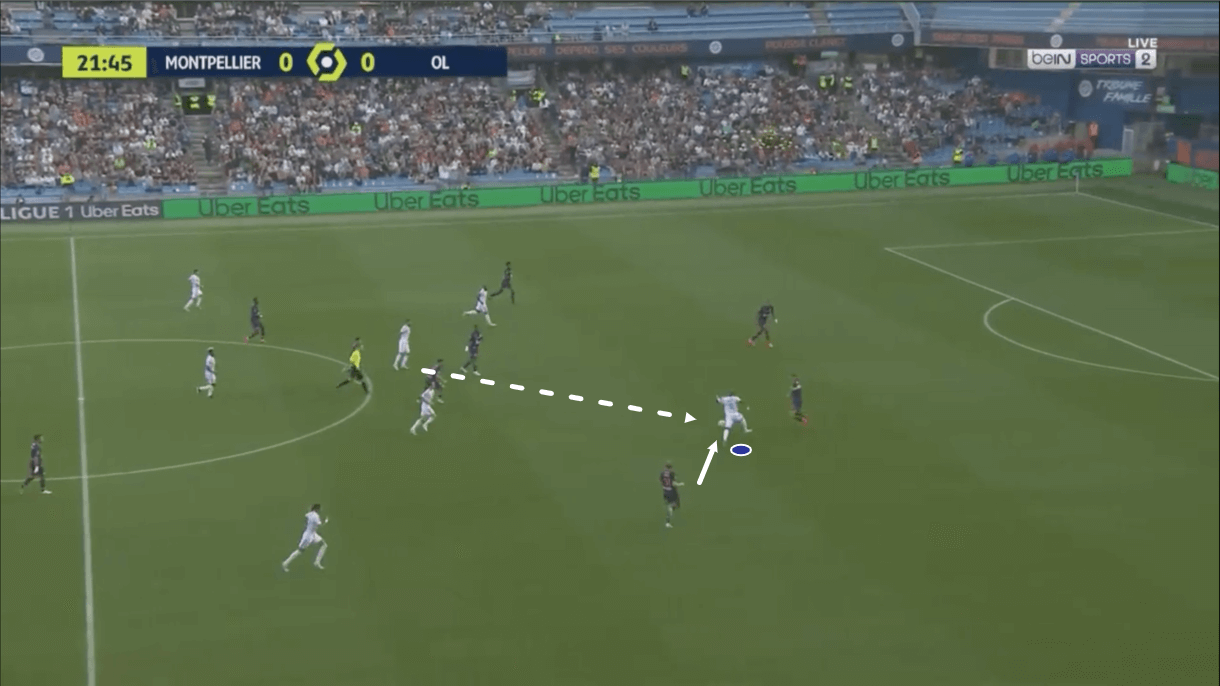
Figures 10-11 highlight an example of Dembélé’s dribbling technique in action. Firstly, as the ball was played towards him in figure 10, the player quickly sped up at the last second, knocking the ball away from the defender who’d thought he had a chance of making an interception. From here, the 26-year-old can progress beyond the centre-back and charge towards goal.
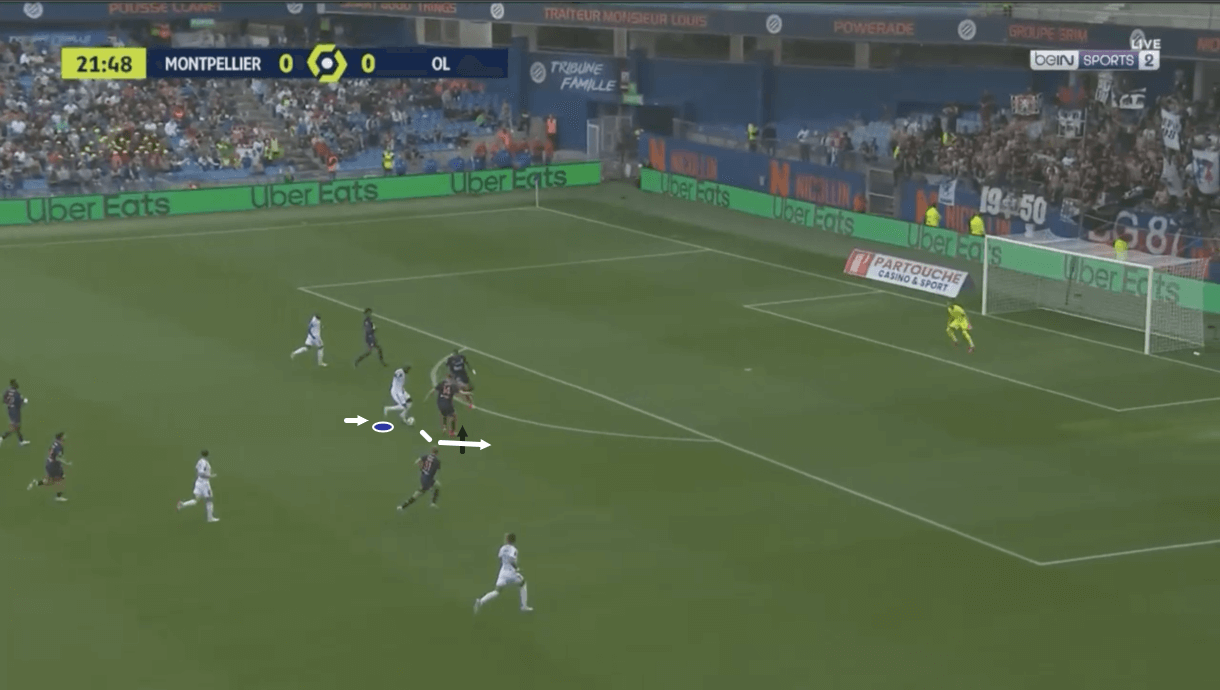
He turns back towards the right after progressing forward a few steps just a few seconds later. As he does so, he pulls out an intelligent move that demonstrates really nice footwork, pulling his leg back but faking the subsequent touch, allowing the defender to commit to a challenge before he makes his next touch of the ball, knocking it around the defender and progressing beyond him once more, carrying on towards the box.
Ideally, you want Dembélé receiving higher, in more advanced positions where you can capitalise on his off-the-ball movement, runs and finishing quality. But if required to pick up the ball deeper and carry it forward, he’s capable; you could definitely have worse ball carriers.
Conclusion
To conclude our scout report, we hope the important elements of Dembélé’s game in terms of goalscoring and chance creation are clear to see from our tactical analysis. His game isn’t perfect — he doesn’t offer a tonne defensively, this is certainly a technical area of improvement and somewhere he could, perhaps, learn to use his physicality better for the team’s benefit, he doesn’t create tonnes for others via his passing — that’s just not his game — and his passing quality could be better even in general link-up play.
However, Dembélé’s someone you get in your team to do the business in front of goal; he’s a finisher and has demonstrated that he’s a very good one in Ligue 1 over the last 12 months when given the opportunity. At present, he represents a brilliant option for a team looking for a profile as described in this piece, likely at a very good price considering his quality.





Comments